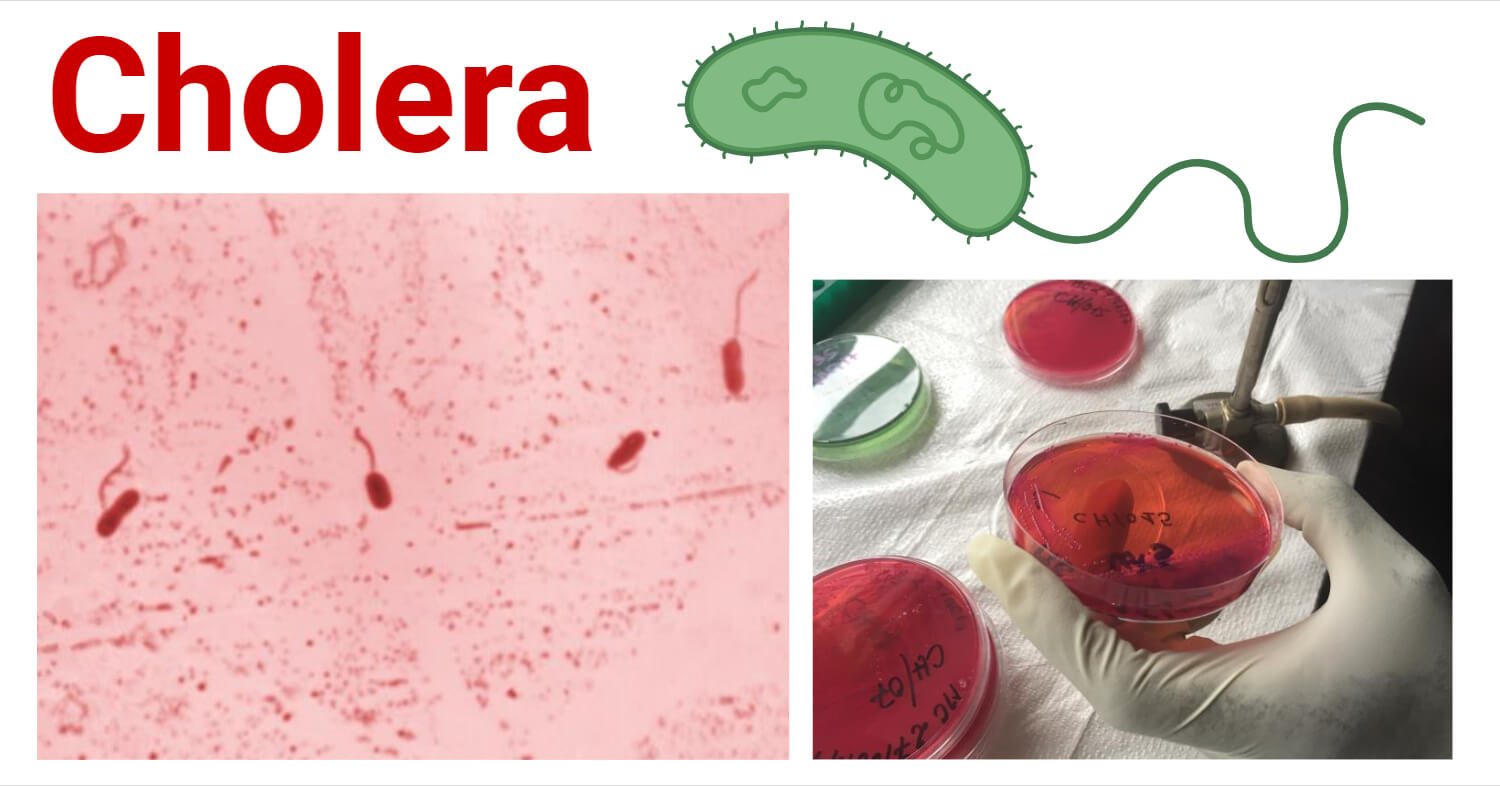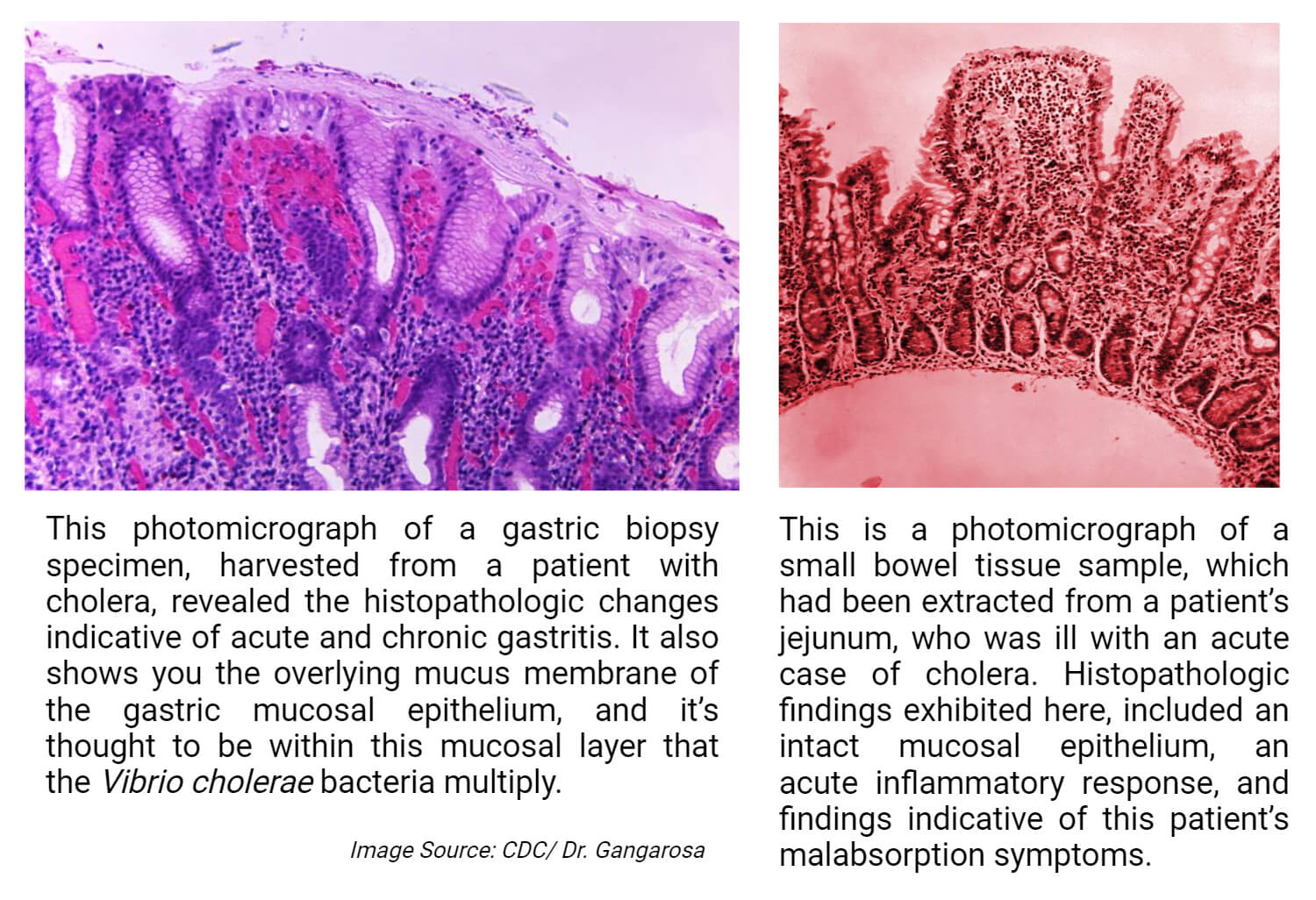Cholera is an infectious disease of the intestine that causes acute diarrhea, which when left untreated can be fatal within a few days. It is caused by a bacterial pathogen, Vibrio cholerae.
V. cholerae is a gram-negative curve-shaped bacteria which prefers to live in aquatic environments. Cholera is believed to have originated from the Ganges delta in India, from where it spread to the African continent and the American continent, ultimately leading to its endemic status in the late 19th Century.

It is commonly referred to as a disease of poverty, as most of the prevention and treatment methods of cholera are strictly limited by the economic status of people. While it is not considered as big a threat in recent times, lack of proper prevention or treatment can quickly turn the disease fatal, a trend which is very common in developing and underdeveloped countries in the world.
In scientific literature, cholera infection has been associated with two major bacterial serotypes, V. cholerae O1 and O139. All worldwide cases have been caused by the O1 variant and the O139 is rarely seen outside of Asia. However, the O139 is common in sporadic cases in Bangladesh as well as other Southeast Asian countries.
Interesting Science Videos
Transmission of Cholera
The bacterium is capable of surviving outside the host body, enabling indirect transmission through fecal matter or through contaminated food and water. Unsanitary water supply that has been contaminated with feces of infected people further accelerates the spread of bacteria. Thus, it is usually classified as a water-borne disease. Three out of four people that are infected are symptomless meaning they can excrete a large number of bacteria without any knowledge.
Cholera usually occurs where there are unsanitary practices, poor water treatment systems and lack of personal and community hygiene. Most cases are usually seen in those areas struck with natural calamities like earthquakes and floods.
Mode of action of Cholera
The site of action for this bacterium is the small intestine and its passage is through the stomach. If the stomach has a pH of 4.5 or less, then it is sufficient enough to kill the bacteria but if not, then the bacteria won’t be harmed and will eventually reach the small intestine. Here it multiplies and produces an enterotoxin called choleragen.
The epithelial intestinal lining is functionally disrupted by the toxin, which in turn causes loss of salt and water from the blood, leading to severe diarrhea. Continued fluid loss, when left untreated for a period of 24 hours or more, can turn fatal for the infected individual.
Clinical Features of Cholera
- Incubation Period
The incubation period can range from a few hours to even 5 days. Factors such as inoculum size and host susceptibility influence the time frame of incubation period.
- Symptoms
Individual symptoms may vary between symptomless, mild as well as severe symptoms. Some of these symptoms include:
- Watery diarrhea (also called rice water stool)
- Sunken eyes
- Thirst
- Dry mouth
- Vomiting
- Muscle cramp
- Restlessness
- Fatigue or irritability
- Complications
Complications due to cholera include, but are not limited to:
- Severe dehydration, which may lead to kidney failure.
- Electrolyte imbalance, which may cause hypoglycemia (low blood sugar) and shock.
Method of Diagnosis of Cholera
Suspicion of cholera arises when a patient suffers from loose and watery diarrhea without blood for a time period of 24 hours. Diagnosis can then be confirmed by stool analysis. In this method, the bacteria is isolated from stool culture using various selective media and biochemical tests are performed to confirm the presence of bacteria.
In the event that stool analysis is not available or feasible, rapid diagnostic kits such as antigen detection-based kits, molecular tests and dark field microscopy can also be used.

Treatment of Cholera
If cholera is treated timely, recovery can be quickly made and often death can also be avoided. On top of that, the treatment process is very simple, utilizing a solution of glucose and salt to act as an electrolyte solution during diarrhea. Glucose is used because it is easily absorbed in the blood and also helps in the uptake of ions such as sodium and potassium.
Based on the severity of cholera, treatment can be classified as:
Primary treatment
Primary Treatment, also known as rehydration therapy, is enough if the infected person is not so severely affected. Treatment is given either orally or intravenously depending upon the need of the patient. For children under 5 years, zinc should be supplemented as an adjuvant therapy. This helps reduce the duration and the severity of illness, as zinc is an important component in the water and electrolyte absorption phenomenon.
Antibiotics treatment
Individuals who are severely ill are given antibiotics along with rehydration treatment. This treatment is also given to pregnant women, HIV infected individuals or people with severe acute malnutrition.
An important thing to consider during treatment is to match the amount of intake of fluid with the amount of loss of fluid through urination and fecal excretion. This helps maintain the osmotic balance of blood and tissues, as over-hydration is equally as dangerous as dehydration.
Prevention of Cholera
The prevention of cholera is a multi-level process that spans personal, community and government efforts for optimal effectiveness. Some common prevention strategies have been listed below:
Personal
Cholera can be easily prevented if we follow simple procedures such as:
- Proper washing of hands after visiting the washroom and before meals.
- Proper boiling and filtration of drinking water.
- Adequate cooking of food to destroy any contaminant pathogens.
Community Level
- Local level awareness regarding the importance of hygiene.
- Provision of electrolytes in shops around the community.
Governmental
- Construction and maintenance of proper water supply system.
- Efficient sewage treatment and disposal of solid waste.
- Vaccination programs
Vaccines against Cholera
Oral vaccines that provide short term immunity are given when an individual is traveling to an area where transmission of cholera is prominent. Mass vaccination is also given during epidemics to control the spread of disease.
Why are cholera vaccines not widely used?
Although cholera has been periodically causing epidemics every now and then, effective vaccines against cholera have not been developed yet.
In the late 19th century, injectable whole-bacteria vaccines were developed, but upon trials it was only found to confer modest immunity for about 6 months. This along with other severe side effects such as fever and pain while injecting led to WHO dropping the vaccine in the 1970s.
Many attempts are being made to develop vaccines that have greater efficacy and follow the oral route. A major roadblock in the vaccine production process is the high expense. For a vaccine to be cost effective it should induce herd immunity, and many of the trial vaccines have shown good results during trials in various areas around Asia and Africa.
Right now, the FDA has approved licenses to three vaccine developers, but these developers have not been able to keep up with the growing vaccine demand.
Global Disease statistics
According to WHO, the number of cholera-infected people ranges from 1.3-4 million, and 21,000 to 143,000 people die worldwide. Most of the outbreaks of cholera usually take place after a natural disaster due to lack of safe drinking water and contamination of existing water resources and reservoirs. Cholera has become endemic in various underdeveloped countries.
In 2022, WHO reported the highest number of cholera cases ever recorded in some countries such as Lebanon, Malawi, Congo, Syria, Haiti, Cameroon etc., all of which are classified as developing or underdeveloped.
Questions and Answers on Cholera
1. Describe how cholera is transmitted from person to person.
The Vibrio cholerae bacteria gets transmitted through the feco-oral route. The feces of an infected person contains bacterial pathogens. If drinking water and food consumed by a healthy individual gets contaminated with this feces, then the bacteria gets transmitted from one person to another.
2. One person can excrete 1013 cholera bacteria a day. The infectious dose is 106. How many people could one person infect in one day?
Number of people the person can infect = amounts of bacteria that is excreted / infectious dose
= 1013/ 106
= 10 million
3. Explain why there is such a high risk of cholera following natural disasters such as earthquakes, hurricanes, typhoons and floods.
After a natural disaster, the surviving people are deprived of proper sanitation, safe drinking water, and uncontaminated food. Also, these kinds of disasters severely disrupt the sewage treatment and drinking water systems in an area. Thus, there is a high risk of spread of cholera after natural disasters such as earthquakes, hurricanes, typhoons and floods.
4. Describe the precautions that a visitor to a country where cholera is endemic can take to avoid catching the disease.
There are provisions for oral vaccinations which confer immunity against the bacteria for a certain period of time for visitors who are traveling to cholera endemic countries. Precautions such as use of bottled drinking water and avoiding raw vegetables are advisable. If the person traveling is staying for a long period of time, then they should regularly get a booster dose of the vaccine.
References
- “A fire that is just going to keep getting bigger”: What you need to know about the global cholera outbreak | Concern worldwide. (2022, August 30). https://concernusa.org/news/global-cholera-outbreak-explained/
- Cholera is endangering children globally. (2023). UNICEF. https://www.unicef.org/stories/cholera-is-endangering-children-globally
- Cholera-Global Situation(2023, February 11). https://www.who.int/emergencies/disease-outbreak-news/item/2023-DON437
- Cholera – Symptoms & causes – Mayo Clinic. (2022, December 9). Mayo Clinic. https://www.mayoclinic.org/diseases-conditions/cholera/symptoms-causes/syc-20355287
- Clemens, J. D., Shin, S., Sur, D., Nair, G. B., & Holmgren, J. (2011). New-generation vaccines against cholera. Nature Reviews Gastroenterology & Hepatology, 8(12), 701–710. https://doi.org/10.1038/nrgastro.2011.174
- Dunkin, M. A. (2010, October 24). Cholera. WebMD. https://www.webmd.com/a-to-z-guides/cholera-faq
- Illness and symptoms | Cholera | CDC. (n.d.). https://www.cdc.gov/cholera/illness.html
- Jones, Mary, Jones, Geoff. (2020). Cambridge IGCSE Biology Coursebook with CD-ROM (5th Edition). Cambridge, UK: Cambridge University Press.
- Mavhunga, C. (2023). Cholera: World Health Organization warns of rising cases in Africa. The BMJ, p488. https://doi.org/10.1136/bmj.p488
- Montero, D. A., Vidal, R., Velasco, J., George, S., Lucero, Y., Gómez, L. A., Carreño, L. J., García-Betancourt, R., & O’Ryan, M. (2023). Vibrio cholerae, classification, pathogenesis, immune response, and trends in vaccine development. Frontiers in Medicine, 10. https://doi.org/10.3389/fmed.2023.1155751
- Regina LaRocque, MD, MPHJason B Harris, MD, MPH (2024) UpToDate. (n.d.). UpToDate. https://www.uptodate.com/contents/cholera-epidemiology-clinical-features-and-diagnosis
